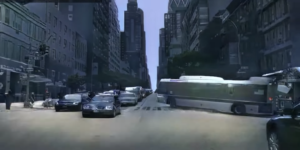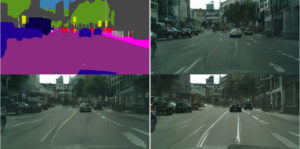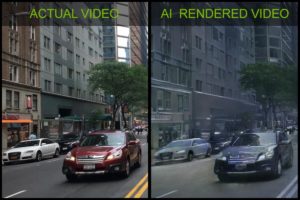The ongoing blast in computerised reasoning has created amazing outcomes in a to some degree astounding domain: the universe of picture and video age. The most recent model originates from chip originator Nvidia, which today distributed research indicating how AI-created visuals can be joined with a customary computer game motor. The outcome is a half and half illustrations framework that would one be able to day be utilised in computer games, motion pictures, and augmented reality.
The consequences of Nvidia’s work aren’t photo-realistic and demonstrate the trademark visual spreading found in much AI-created symbolism. Nor are they absolutely novel. In an exploration paper, the organisation’s architects clarify how they based upon various existing strategies, including a persuasive open-source framework called pix2pix. Their works conveys a kind of neural system known as a generative antagonistic system, or GAN. These are broadly utilised in AI picture age, including for the making of an AI representation as of late sold by Christie’s.

Nvidia’s framework produces designs utilising a couple of steps. To begin with, analysts need to gather preparing information, which for this situation was taken from open-source data-sets utilised for self-governing driving exploration. This recording is then fragmented, which means each edge is broken into various classes: sky, vehicles, trees, street, structures, etc. A generative ill-disposed system is then prepared on this portioned information to create new forms of these articles.
“The structure of the world is being made generally,” clarifies Catanzaro, “the main thing the AI creates is simply the illustrations.” He includes that the demo itself is fundamental, and was assembled by a solitary architect. “It’s confirmation of-idea as opposed to a game that is enjoyable to play.”

The innovation is especially at the beginning times, stresses Catanzaro, and it will probably be a very long time until AI-created illustrations appear in shopper titles. He looks at the circumstance to the improvement of beam following, the current hot system in illustrations rendering where individual beams of light are produced continuously to make reasonable reflections, shadows, and haziness in virtual situations. “The specific first intelligent beam following demo happened a long, long time prior, however we didn’t get it in game until only half a month back,” he says.

The organisation, however, says this is not really another issue. “Will [this technology] be utilised for making content that is deluding? Indeed. Any development for organising can be utilised to do that,” says Catanzaro. He says Nvidia is carrying on with accomplices to inquire about strategies for recognising AI fakes, however that at last the issue of deception is a “trust issue.” And, in the same way as other trust issues before it, it should be explained with a variety of techniques, not simply mechanical.

The organisation, however, says this is not really another issue. “Could [this technology] be utilised for making content that is deceiving? Indeed. Any innovation for rendering can be utilised to do that,” says Catanzaro. He says Nvidia is working with accomplices to explore strategies for recognising AI fakes, yet that eventually the issue of falsehood is a “trust issue.” And, in the same way as other trust issues before it, it should be fathomed with a variety of techniques, not simply innovative.
Source: The Verge and Nvidia








